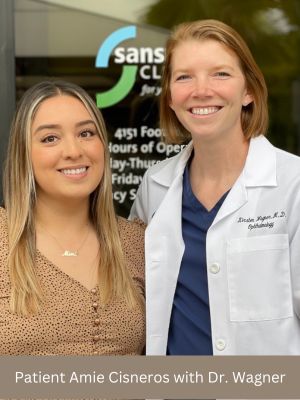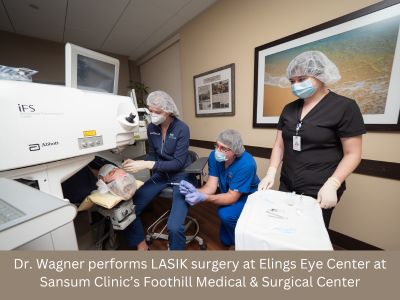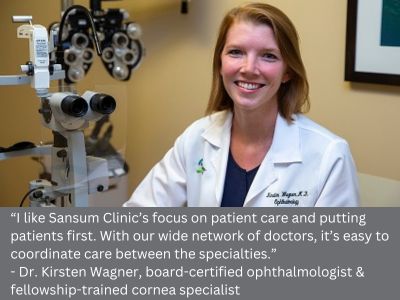Jun 20, 2023, 15:49
by
Good Health Digital Edition

Amie Cisneros first considered LASIK during the pandemic when the mask she wore at her job as an ophthalmic assistant made her eyes dry and fogged up her glasses. She also wanted to end the irritation she experienced when wearing contacts. When she spoke to ophthalmologist and cornea specialist Kirsten Wagner, MD, she learned how LASIK could improve her symptoms and her eyesight. “I felt very prepared to move forward after discussing LASIK with Dr. Wagner,” describes Amie. “She explained everything in detail and went over all of the steps so I knew what to expect.” The thought of no problems with contacts and no more glasses was greatly appealing to Amie, so she proceeded to schedule her LASIK surgery. When it was over, Amie went home to take a nap and when she woke up, she could hardly believe how she already had a noticeable improvement in her vision. “The entire thing was quick and easy. This is clearly one of the best decisions I have made in a long time. I don’t have to worry at all anymore about contacts or glasses,” shares Amie.
How LASIK Works
LASIK alters the shape of the cornea to improve vision by correcting a variety of refractive errors like nearsightedness, farsightedness, or astigmatism. Nearly 700,000 Americans get LASIK surgery each year, according to the Food and Drug Administration (FDA). The procedure has a high success rate, improving vision to 20/20 in more than 90% of patients. Ninety-five percent of people who undergo this laser-assisted surgery say they are greatly satisfied with the results. LASIK has advanced tremendously, improving outcomes and reducing side effects since it was first approved by the FDA in 1998. A 2017 analysis of FDA data showed that the newest lasers have reduced unwanted side effects significantly compared to older generation lasers.
Advanced LASIK Increases Safety
Sansum Clinic’s state-of-the-art LASIK technology is bladeless, greatly increasing safety. The innovative Intralase and iDesign Advanced Wave Scan tracks pupil motion so the procedure can be completed even if the eye moves. All of this means more reliable vision improvement and faster recovery times for patients. “Patients visually track a blinking orange light during the procedure, but the laser knows to stop if the pupil is not centered. We pause the procedure, the patient refocuses and we pick up right where the treatment left off,” explains Dr. Wagner.

Good Candidates for LASIK
Whether you’d like to stop wearing contacts or glasses, or only want better distance vision, the most appropriate LASIK candidates are at least 21 years old, in good general health, and have used a stable eye prescription for at least one year. All qualifying patients undergo a full eye exam to ensure they are a good candidate for the procedure. Dr. Wagner insists on discussing all of the risks and benefits with each of her patients. The risks of LASIK have been studied extensively, and the research shows that serious complications are rare. The American Refractive Surgery Council says the procedure’s complication rate is less than 1%, and a majority of patients are happy with the results. "The risk of seeing glare or halos after surgery is less than two percent because of that custom treatment that we’re doing,” notes Dr. Wagner. “Overall, this procedure has had a very good track record, but it is important to select a surgeon who is highly-trained and experienced in LASIK and a variety of vision correction surgeries, and to know that the LASIK technology being used is the most advanced on the market,” says Dr. Wagner.

Quick Painless LASIK Procedure
Dr. Wagner creates a custom LASIK plan for each person's specific prescription, adapting the treatment to his or her specific measurements. The entire procedure takes about 15 minutes. Patients generally are awake, their eyes numbed with drops to remain pain-free. “Most people notice the positive change in their vision the very next day, with the biggest jump in vision during the first week. Vision can continue to improve even at six months after the procedure,” explains Dr. Wagner. She has found many people who now work remotely or are on computers all day, are looking for relief from eye strain and fatigue. Improved vision and less time wearing glasses has been an appreciated solution. “My LASIK patients are thrilled to be able to wake up and see the clock in the morning, or play sports and swim without worrying about glasses or contacts. It really does greatly improve your quality of life,” she says. Nearly two years after her LASIK surgery, Amie likes that she no longer has to keep up with prescriptions or remember to order enough contacts to last through the month. “I can now do any activity without worrying about glasses or contacts,” she reports. “I couldn't be happier with my vision!”
Connect With Our Team
Sansum Clinic’s multi-specialty eye care center provides a full range of eye treatments for patients of all ages, including cataract surgery, corneal/refractive and corneal transplant surgery, cosmetic procedures and eye muscle and eyelid surgery. We have the area’s only surgical glaucoma specialist and only pediatric ophthalmology provider.
Learn more about our Ophthalmology Department >
Learn more about LASIK >